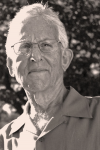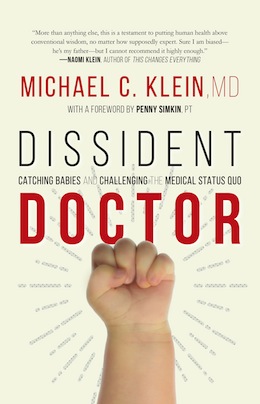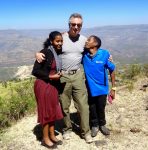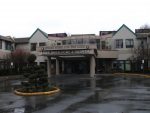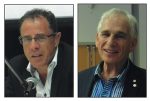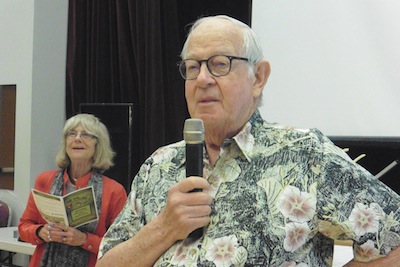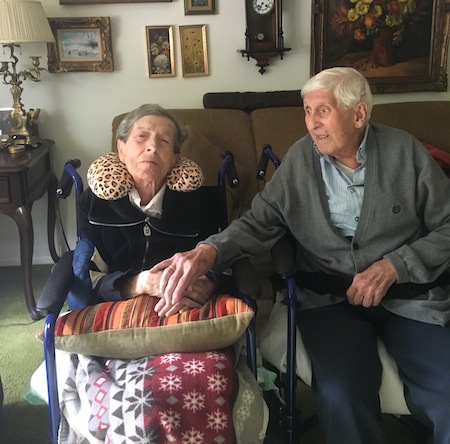Fantaye, Gary Segal and Tesfaye in 2015, on a return visit by Segal to Gojam, Ethiopia. (photo from Gary Segal)
Thirty-seven spine surgeries, six nursing/midwifery scholarships, development of Sebi Sarko Rural Health Centre and the establishment of a pediatric program reaching more than 14,000 children living in rural areas. That’s part of what has been accomplished with the $1 million-plus that was raised in Vancouver five years ago at An Evening to Bring Back Hope.
The 2012 event honoured Dr. Rick Hodes, medical director of Ethiopia for the American Jewish Joint Distribution Committee (JDC) and senior consultant at Mother Teresa Mission. It also established a partnership between JDC in Ethiopia and the University of British Columbia Branch for International Surgical Care. With the monies raised in 2012, UBC Branch has developed curriculum with Hodes and engaged in spine-disease research in Ethiopia; as well, there have been physician and nurse exchanges between UBC-Vancouver General Hospital and Ethiopia’s Gondar Hospital.
This year, on June 8, An Evening to Bring Back Hope honours both Hodes and spine surgeon Dr. Oheneba Boachie-Adjei, and raises funds for the continuation and expansion of their work, as well as that of JDC and UBC Branch. Boachie, president and founder of FOCOS (Foundation of Orthopedics and Complex Spine) in Accra, Ghana, has performed most of the complex surgeries on Hodes’ spine patients since the two doctors starting working together in 2006.
The fundraising event includes a symposium and lunch at Congregation Beth Israel, at which attendees will be able to ask JDC staff questions about JDC’s humanitarian work and philanthropy, and a gala dinner at Vancouver Convention Centre-East. Event partners are JDC, UBC Branch and the Jewish Federation of Greater Vancouver. As in 2012, gala chairs are Gary and Nanci Segal.
“I am very pleased that Dr. Boachie will also be a focus of attention at the event,” Gary Segal told the Independent. Hodes, an observant Jew, and Boachie, a devout Baptist, “together work tirelessly to treat the sick and poor of all religions and ethnicities.”
“I truly believe that in today’s world filled with negativity, intolerance and discord, this cause and message of inclusion and multiculturalism resonates louder than ever,” said Segal.
Segal first met Hodes as part of a Federation/JDC trip to Ethiopia in 2007. He spent more time with Hodes on a family trip in 2008. “The more time I spent with Rick in clinic and at his home with his very large family of adopted and fostered children that all needed Rick’s help, the more heroic and inspiring Rick and his life story became to me,” said Segal. When hosting Hodes and his extended family of 18 children (at the time) for dinner, Segal learned that Tesfaye – whose spine had collapsed from tuberculosis – could not be operated on in Ghana, and thought, “I knew that I had to do whatever I could to save Tesfaye’s life.”
According to the fundraiser’s website, Segal “spent almost a year pursuing the possibility of bringing Tesfaye to Vancouver for spine surgery and, finally, on his 18th birthday, May 20, 2009, Tesfaye arrived in Vancouver and was welcomed into the Segal home. On June 12, ‘Team Tesfaye,’ led by surgeon Dr. Marcel Dvorak at VGH … successfully perform[ed] delicate 14-hour life-saving surgery.”
“For decades,” Segal told the Independent, “I have always given of my time and money to help a variety of community organizations and causes – I grew up with wonderful examples of this in both my mother and father. Helping Tesfaye was a unique experience, where the ‘giving back’ became such an intimate, personal and integral part of my life.
“On my 2010 trip back to Ethiopia after Tesfaye’s surgery, I retraced and revisited what his life was like before surgery. Understanding Tesfaye’s courage, dignity, perseverance and optimism – that he kept in the direst, most uncomfortable and debilitating of situations – motivates and inspires me daily, and always keeps my problems in perspective.
“Seeing the transformation in Tesfaye’s life and what it has meant to his family and entire village, further inspired me to found this Bring Back Hope initiative,” he continued. “One of the highlights of my life was that 2010 trip to Tesfaye’s remote village in Gojam – a typical village with mud huts, no electricity or running water – as the entire village celebrated his miraculous rebirth for three days, with feasting, chanting and Agew shoulder dancing. Seeing ‘up close and personal’ the impact of changing even one individual’s life, it became my vision to introduce Rick’s story to more people by holding a large dinner of caring people from different faiths and backgrounds, and to hopefully raise a lot of money to change more lives. Thus, the Bring Back Hope initiative was launched through the inaugural Evening to Bring Back Hope 2012.”
But his efforts extend beyond the events. “I never imagined before meeting Tesfaye that, one day, I would have a whole extended family in Ethiopia become part of my family,” he said.
It was hoped that Tesfaye’s sister, Fantaye, would be joining her brother at this year’s Bring Back Hope. Unfortunately, she won’t be able to make it – but for “good news” reasons, said Segal, “as she is about to graduate from Grade 12 at a high school in Ethiopia’s capital city Addis Ababa and the national exams she has to write to qualify for university only end on June 8.”
“I met Fantaye in February of 2010,” explained Segal, “when I flew over to Ethiopia to accompany Tesfaye on the journey out to his remote village in Gojam to be with him to experience his family and village seeing him standing upright for the first since he was crippled with TB of the spine at 8 years of age…. Tesfaye, living in the capital Addis Ababa since he was 12, heard that his mother wanted Fantaye to get married; he was concerned she was too young, being only 12 years old, and feared the husband’s family would force her, once she was married, to stop going to the village school. At his request, I asked his mother, Yeshi, to wait until Fantaye was older and completed school, but, sure enough, she was married a few months later, at the age of 12.”
When Segal returned to Ethiopia in December 2012 on a Bring Back Hope-related trip, he found, to his “surprise and delight,” that, “through Tesfaye’s persistence and insistence, Fantaye had left her husband and village to join her brother in Addis Ababa and live with him and go back to school. This took a lot of courage on the part of a then 14-year-old girl, going against the wishes of her family and entire village. At the same time, it took Tesfaye’s courage of conviction as to what was right for his sister for this to happen; I attribute this to Tesfaye understanding the greater world outside the village and Fantaye seeing the transformation of Tesfaye.”
Even after 27 years working with JDC in Ethiopia, Hodes still finds inspiration from his patients.
“The courage which Ethiopians live with who have spinal deformities is simply inspiring,” Hodes told the Independent. “Kids who are in pain but still go to school, kids who are teased at school but persist, kids who have no parents and are self-supporting as young teens but go to school and come for treatment.
“And the love which they show for each other is exemplary. I have a single mom who has a paralyzed son who has simply devoted her entire day – every day – to caring for this boy, who is now improving. In fact, I just brought him to Ghana five days ago for intensive physical therapy to see if we can jump-start his improvement.
“I bought a bag of cookies for a young boy with a bad back. He put them in his pocket. ‘Why don’t you eat it?’ I asked. ‘Later,’ he said, ‘I want to share it with my brother.’
“I have another mom who has a son who had a complex heart problem giving him very little oxygen. This boy could not walk more than three steps and the mom has made sure that he moves forward in life by carrying him, piggy-back, everywhere. She carried him to school, carries him home, brought him to Addis Ababa every month for phlebotomy, to remove the extra blood his body produces. And now he’s able to walk, after corrective heart surgery in India.
“I had an orphan boy with no relatives at all,” continued Hodes. “He came to Addis Ababa, supported himself by shining shoes, went to school and slept in a taxi at night until someone took him into their home. He, too, has had surgery and is now back in school.
“When I’m having a tough day – I frequently feel overwhelmed – it’s patients like this who keep me going, and remind me why I’m here.”
Hodes’ International Life-Saving Surgery Program 2016 annual report describes that year as “game-changing.”
“This was the first year that the Ethiopian government gave us support – they paid for the air tickets of 22 patients to Ghana for spine surgery,” explained the doctor. “They are continuing the air ticket support this year.”
Also in 2016, he said, “Our contract with the Ethiopian government ended its standard, three-year period and the program closed for evaluation. It was given an unprecedented five-year renewal.
“We have moved into new facilities at a government trauma hospital called AaBET [Addis Ababa Burn Emergency Medicine and Trauma] Hospital, where we see patients five days a week. We have started discussions to send two Ethiopian doctors to Canada for spine training. We now have several teams coming to Ethiopia to operate – in fact, we have three different spine teams coming this month, and will get at least 40 surgeries done inside Ethiopia!”
In addition to treatments, there have been discoveries. “We have described some new deformities, which we are now defining with Greek letters,” said Hodes. And, he added, “We believe we’ve made a major discovery about spine deformities caused by neurofibromatosis.”
In 2016, Hodes said there were 359 new spine patients, with 111 surgeries conducted on 105 patients. “We got two spines done in the U.S., and helped two patients go to India for heart care,” he said. “So far this year, we have 101 new spine patients.”
Hodes said the price for spinal surgeries ranges from $13,000 (or a little less) to $21,000, averaging about $18,000. For hearts, he said, “some patients need procedures (done in the catheterization laboratory) where a balloon is blown up to expand a narrowed valve or close a hole in the wall of the heart. Those cost around $2,000. Surgery costs depend on the complexity of the case, and generally run from $5,000-$10,000.
“If we get surgery done in North America, it’s at no cost to us, other than an air ticket. We just had two boys return from complicated surgery in Texas, and another from California.”
Hodes stressed, “I cannot sufficiently thank the people of Vancouver who are helping me. Their help is, quite literally, life-saving.”
For tickets to the gala ($500, with tax receipts issued for eligible portion) and sponsorship information, call Mercedes Dunphy at 604-710-4491 or Nanci Segal at 604-813-5550. For more information on the initiative, visit bringbackhope.com.



